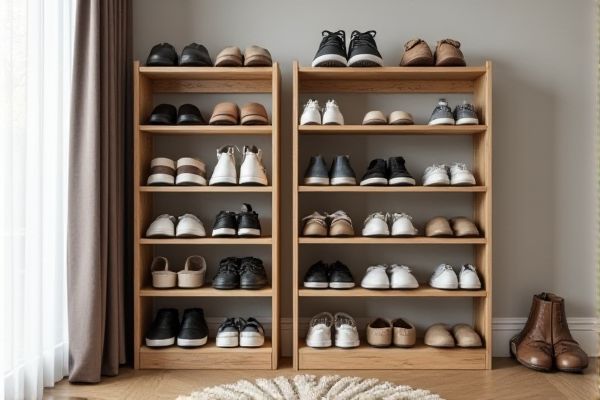
Choosing between a vertical shoe rack and a horizontal shoe rack depends on your space and organizational needs; vertical racks save floor space and are ideal for narrow areas, while horizontal racks offer easier visibility and access to your shoes. Discover how to optimize Your shoe storage by reading the rest of this article.
Table of Comparison
| Feature | Vertical Shoe Rack | Horizontal Shoe Rack |
|---|---|---|
| Space Efficiency | Maximizes vertical space, ideal for small areas | Requires more floor space, better for wide spaces |
| Capacity | Holds more shoes in a compact footprint | Usually holds fewer shoes but provides easier access |
| Accessibility | Shoes stacked vertically can be harder to access | Shoes are easier to see and grab |
| Design & Aesthetics | Modern, space-saving look | Traditional, display-friendly style |
| Portability | Generally lightweight and portable | Heavier and less portable |
| Best Use | Small apartments, closets with limited floor space | Larger rooms, open spaces |
Introduction to Vertical and Horizontal Shoe Racks
Vertical shoe racks maximize storage by utilizing upward space, ideal for small rooms or entryways with limited floor area. Horizontal shoe racks spread shoes across a wider footprint, offering easier access and visibility, suitable for larger spaces or organized display. Choosing between vertical and horizontal racks depends on room dimensions, shoe collection size, and accessibility preferences.
Space Efficiency: Vertical vs. Horizontal Designs
Vertical shoe racks maximize space efficiency by utilizing height, making them ideal for small rooms or tight corners where floor space is limited. Horizontal shoe racks spread shoes in a single layer, requiring more floor area but providing easier access and visibility for your collection. Choosing between vertical and horizontal designs depends on your available space and preference for accessibility.
Capacity and Storage Comparison
Vertical shoe racks maximize capacity by using upward space, fitting more pairs in a smaller footprint, ideal for limited floor areas. Horizontal shoe racks spread shoes across a wider base, offering easier access but occupying more floor space and typically holding fewer pairs. Your choice depends on balancing storage needs with available space and accessibility preferences.
Accessibility and User Convenience
Vertical shoe racks maximize accessibility by utilizing height, allowing users to quickly locate and grab shoes without bending or crouching, which enhances convenience especially in small spaces. Horizontal shoe racks provide easier visibility and access to each pair at a glance, making them ideal for users who prefer to see all shoes simultaneously. Choosing between vertical and horizontal shoe racks depends on the balance between space constraints and the preference for ease of reach or comprehensive display.
Style and Aesthetic Appeal
Vertical shoe racks maximize space while offering a sleek, modern design that complements minimalist interiors, making them ideal for compact areas. Horizontal shoe racks provide a traditional, open display that allows you to easily showcase your entire collection, adding warmth and character to your room's decor. Your choice depends on whether you prioritize streamlined storage or visible accessibility to enhance your living space's style.
Material and Durability Considerations
Vertical shoe racks often use metal or wood frames with mesh or plastic shelves, offering sturdy construction and space-saving durability ideal for tight areas. Horizontal shoe racks typically feature solid wood or laminated boards, providing stable support for heavier shoes but requiring more floor space and potentially less resistance to wear over time. You should evaluate your space constraints and shoe storage needs to choose a material and design that maximizes longevity and practicality.
Installation and Maintenance Differences
Vertical shoe racks typically require wall mounting or freestanding assembly, involving minimal tools and space-efficient design, while horizontal shoe racks often rely on shelving units needing more floor space and sometimes heavier installation. Maintenance for vertical racks is easier due to limited dust accumulation on narrow surfaces, whereas horizontal racks can gather more dust and require frequent wiping. Your choice should consider both the installation complexity and ongoing upkeep based on room layout and cleaning preferences.
Cost and Value for Money
Vertical shoe racks generally offer better value for money due to their space-saving design, allowing more shoes to be stored in a compact footprint, which can be particularly cost-effective for small living areas. Horizontal shoe racks, while often priced similarly, tend to occupy more floor space, potentially requiring larger furniture pieces or rooms, which might lead to additional costs in terms of space utilization. Choosing a vertical shoe rack can maximize storage efficiency without significantly increasing expenses, making it a more economical choice for budget-conscious consumers.
Best Use Cases for Each Shoe Rack Type
Vertical shoe racks are ideal for small spaces, maximizing storage by utilizing height and fitting efficiently into narrow areas like closets or entryways. Horizontal shoe racks offer easier access and better visibility, making them suitable for larger rooms or walk-in closets where shoes are frequently rotated. Both types enhance organization, but choice depends on available space and user preference for convenience or capacity.
Choosing the Right Shoe Rack for Your Home
Vertical shoe racks maximize storage by using height, making them ideal for small spaces or closets, while horizontal shoe racks offer easier access and display, suitable for wider areas or entryways. Your choice depends on available space, shoe quantity, and convenience preferences to keep your footwear organized efficiently. Consider vertical racks for compact rooms and horizontal racks if you want quick visibility and retrieval.
 homyna.com
homyna.com